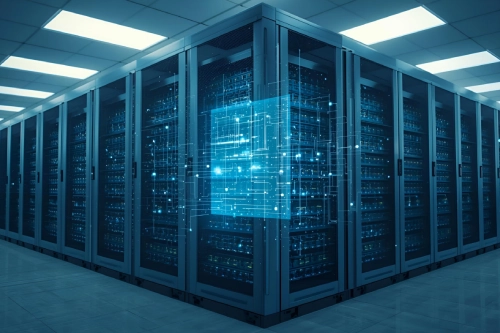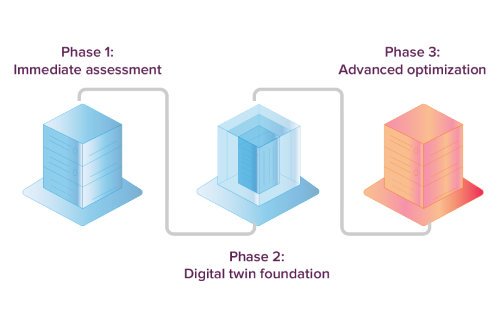Introduction

Data center operators are encountering exceptional thermal management challenges. NVIDIA’s B200 GPU demonstrates 1200W TDP [1], while Intel’s next-generation Jaguar Shores processor is expected to match or exceed similar power levels in 2025-2026[2]. Traditional air-cooling systems are insufficient for these power densities. The liquid cooling market is experiencing a 40.3% CAGR, projected to reach $89.77 billion by 2037 [3], with 22% of data centers already implementing liquid cooling systems [4].
Multi-physics simulation platforms coupled with real-time digital twins provide a viable solution path. Organizations implementing these technologies within the next 12 months can avoid performance throttling, reduce total cost of ownership, and meet sustainability requirements.
Today’s thermal market reality
Global data center energy demand is projected to double within five years [5], driven by AI workloads requiring up to 300% more power than their predecessors [5]. Rack power densities are escalating from the current global average of 12kW to 50kW, 100kW, and beyond 300kW per rack for AI-dedicated facilities [5]. Single-phase direct-to-chip cooling has emerged as the leading approach [6], with cold plate cooling expected to experience significant growth due to cost effectiveness and compatibility with existing air-cooled data centers [1]. Immersion cooling becomes necessary for GPU configurations exceeding 150kW per rack, though broad implementation remains concentrated in AI facilities [5].
Digital twin implementations are expanding rapidly across data center operations. Schneider Electric has partnered with ETAP to develop electrical digital twin platforms based on NVIDIA Omniverse [7]. NVIDIA provides pre-designed 3D assets for DGX A100 SuperPOD hardware, enabling direct digital twin construction [8]. The global digital twin market is projected to reach $110 billion by 2028 [9].
Technical implementation architecture
Established platforms, including COMSOL Multiphysics [10], ANSYS [11], and Siemens Simcenter [12], offer mature, production-ready solutions with extensive deployment across industries. ANSYS provides specialized CFD solvers for electronics thermal management, predicting airflow, temperature, and heat transfer in IC packages, PCBs, and power electronics [11]. These platforms integrate five critical physics domains:
-
Computational Fluid Dynamics (CFD)
Airflow modeling, liquid flow analysis, and heat transfer calculations across chip, board, and facility levels. -
Heat transfer analysis
Conduction, convection, and radiation modeling across materials and interfaces, including conjugate heat transfer for simultaneous fluid and solid analysis. -
Electromagnetics integration
Power delivery, EMI/EMC coupling, and thermal generation analysis for complete system understanding. -
Structural mechanics
Thermal stress, warpage, and reliability assessment under thermal loads. -
Advanced cooling technologies
Direct-to-chip cooling, immersion cooling (single-phase and two-phase), and two-phase cooling systems for next-generation thermal management[6].
Real-time digital twin architecture
Digital twins enable continuous identification of improvement opportunities when connected to environmental monitoring systems [13]. Cadence Reality DC Digital Twin (formerly Future Facilities, acquired by Cadence in 2022) provides physics-based 3D simulation, encompassing virtual representations of power, cooling, and IT systems. The platform now integrates with NVIDIA Omniverse APIs for enhanced visualization and simulation capabilities [14]:
- Sensor integration networks: Temperature, humidity, pressure, airflow, and vibration monitoring
- Real-time data processing: Sub-second response times for thermal event detection
- Predictive analytics engine: Machine learning models trained on historical thermal patterns
- Control system integration: Automated responses to thermal conditions via BMS interfaces
API-first integration strategy
Modern DCIM systems require seamless integration. Raritan’s SmartSensors integrate with existing DCIM suites, serving as the foundation for real-time digital twins [9]. Implementation requires:
- RESTful APIs for real-time data exchange between simulation platforms and facility systems
- Integration with existing Building Management Systems (BMS)
- Compatibility with CI/CD pipelines for continuous model updates
- Support for industry-standard protocols (BACnet, Modbus, SNMP)
The phased implementation framework

Phase 1: Immediate assessment
Conduct thermal capacity assessment using established simulation platforms. Current market data indicates that 22% of data centers have liquid cooling systems in place [4]. Organizations should identify both retrofit opportunities and greenfield requirements. Key deliverables include:
- Current thermal capacity mapping using CFD analysis
- Liquid cooling ROI analysis with direct-to-chip vs. immersion comparison
- Integration assessment with existing DCIM and BMS systems
- Pilot deployment scope definition
Phase 2: Digital twin foundation
Deploy sensor networks and establish digital twin capabilities. Digital twin virtualization provides a structured framework for addressing data center thermal challenges [15]. Implementation priorities:
- Sensor network deployment across critical thermal zones
- Integration with chosen multi-physics simulation platform (COMSOL, ANSYS, or Siemens)
- Real-time data pipeline establishment
- Initial thermal model validation
Phase 3: Advanced optimization
Implement sensor-based temperature monitoring and analytics with AI technology to process data and identify optimization opportunities [4]. Advanced capabilities:
- Predictive thermal analytics deployment
- Automated cooling optimization systems
- What-if scenario modeling for capacity planning
- Integration with workload orchestration systems
Key performance metrics and validation
Establish baseline measurements before implementation:
- Current PUE (Power Usage Effectiveness) values
- Thermal throttling frequency and duration
- Cooling energy consumption percentages
- Mean time between thermal events
Target improvements:
- Immersion cooling can reduce energy consumption by up to 30% [16]
- Predictive maintenance reducing thermal-related downtime
- Improved rack utilization through better thermal management
Ensuring security and compliance framework
- Data protection requirements
Multi-physics simulation networks process sensitive operational data requiring robust security:- Data residency compliance for thermal and operational metrics
- API security for real-time sensor data transmission
- Audit trail capabilities for thermal event investigation
- Integration with existing SOC2 and GDPR compliance frameworks
- Cybersecurity considerations
Digital twin implementations generate substantial operational data that requires protection [17]. Security considerations include:- Network segmentation for sensor and control systems
- Encrypted data transmission between simulation platforms and DCIM systems
- Access controls for thermal management interfaces
- Regular security assessments of digital twin infrastructure
Build vs. Buy decision matrix
Schneider Electric’s partnership with ETAP demonstrates the maturity of vendor ecosystems [7]. Organizations should evaluate the following:
- Established platform advantages:
- Cadence Reality DC provides customized, digitized 3D virtual replicas with full DCIM integration [14]
- Proven track record with existing installations
- Vendor support and professional services availability
- Regulatory compliance and industry certifications
- Custom development considerations:
- Extended development timelines (24-36 months typical)
- Internal expertise requirements across mechanical, thermal, and software engineering
- Ongoing maintenance and support obligations
- Integration complexity with existing systems
- Hybrid implementation strategy:
- Leverage established simulation platforms for core multi-physics modeling
- Develop custom interfaces for specific operational requirements
- Partner with specialized vendors for digital twin implementation
- Maintain internal expertise for operational optimization
Evolving thermal landscape
- Autonomous thermal management
Data center digital twins enable AI/ML model training on CFD simulation data, allowing designers to visualize and evaluate what-if design scenarios [8]. Next-generation capabilities include:- Self-optimizing cooling systems with reinforcement learning
- Predictive workload placement based on thermal capacity
- Automated liquid cooling deployment decisions
- Waste heat recovery optimization through simulation modeling
- Advanced cooling technologies integration
Various liquid cooling technologies are maturing, including traditional cold plates, microfluidic microchannels, micro-convective, and other approaches[6]. Multi-physics platforms must accommodate:- Two-phase cooling system modeling for extreme heat loads
- Hybrid air-liquid cooling optimization
- Phase change material integration modeling
- Advanced thermal interface material performance prediction
- Edge computing thermal optimization
Extending multi-physics simulation networks to distributed edge deployments requires:- Lightweight simulation models for real-time edge processing
- Centralized thermal intelligence with edge execution
- 5G/6G integration for real-time thermal data transmission
- Autonomous edge cooling system management
Implications for CTOs
Reactive approaches to thermal management are no longer sufficient for current power densities. Intelligent cooling management systems with IoT sensors and AI optimization can drive energy savings and improve operational efficiency [18].
- Establish multi-physics simulation capabilities
Choose mature platforms (COMSOL, ANSYS, Siemens) with proven track records. Avoid custom development for core simulation functionality.
- Deploy digital twin infrastructure
Digital twins provide strategic insights for informed decision-making, proactive risk mitigation, and resource optimization to reduce operational costs [19]. Start with critical facility components and scale systematically.
- Accelerate liquid cooling adoption
In new construction, liquid cooling infrastructure has become the default installation [5]. Evaluate direct-to-chip cooling for immediate deployment and immersion cooling for future AI workloads.
- Build internal expertise
Recruit thermal engineers, CFD specialists, and data scientists. Traditional data center operations teams require additional multi-disciplinary expertise for advanced thermal management.
- Integrate sustainability metrics
Link thermal management improvements directly to PUE reduction and carbon footprint goals. Data centers currently consume approximately 2% of global electricity [16].
How implementation partners accelerate data center optimization
Organizations requiring rapid deployment of multi-physics thermal management solutions should consider partnerships with established engineering services providers. Companies like Quest Global, with over 28 years of engineering expertise across mechanical product engineering, digital solutions, and thermal management systems, offer the multi-disciplinary capabilities needed for successful implementation. Their experience spanning semiconductors, hi-tech, and energy sectors provides the cross-industry perspective essential for advanced thermal management deployments.
Such partnerships can accelerate implementation timelines, provide access to specialized expertise, and reduce the risk associated with building internal capabilities from scratch.
References
[1] IDTechEx. (2024). “Thermal Management for Data Centers 2025-2035: Technologies, Markets, and Opportunities.” https://www.idtechex.com/en/research-report/thermal-management-for-data-centers/1036
[2] Tom’s Hardware. (2025). “Intel cancels Falcon Shores GPU for AI workloads; Jaguar Shores to be successor.” https://www.tomshardware.com/tech-industry/artificial-intelligence/intel-cancels-falcon-shores-gpu-for-ai-workloads-jaguar-shores-to-be-successor
Note: Intel’s Falcon Shores (originally planned with 1500W TDP) has been cancelled and will only be used internally. Jaguar Shores is now Intel’s next‑generation AI processor, utilizing 18A process technology with HBM4 memory.
[3] Research Nester. (2025). “Data Center Liquid Cooling Market size to hit $89.77 billion by 2037 | 40.3% CAGR Forecast.” https://www.researchnester.com/reports/data-center-liquid-cooling-market/4747
[4] Data Center Knowledge. (2025). “Data Center Cooling: Trends and Strategies to Watch in 2025.” https://www.datacenterknowledge.com/cooling/data-center-cooling-trends-and-strategies-to-watch-in-2025
[5] JLL. (2025). “2025 Global Data Center Outlook.” https://www.us.jll.com/en/trends-and-insights/research/data-center-outlook
[6] Data Center Dynamics. (2025). “Four key trends disrupting data centers in 2025.” https://www.datacenterdynamics.com/en/opinions/four-key-trends-disrupting-data-centers-in-2025/
[7] The Register. (2025). “Schneider plugs into digital twins for AI datacenter design.” https://www.theregister.com/2025/03/19/schneider_electric_nvidia_digital_twin/
[8] NVIDIA. (2025). “Data Center Digital Twins — Omniverse Digital Twins.” https://docs.omniverse.nvidia.com/digital-twins/latest/data-center.html
[9] Raritan. (2025). “Solving the Problem of the Data Center Digital Twin.” https://www.raritan.com/blog/detail/solving-the-problem-of-the-data-center-digital-twin
[10] COMSOL. (2025). “COMSOL – Software for Multiphysics Simulation.” https://www.comsol.com/
[11] ANSYS. (2025). “Thermal Analysis and Simulation Software.” https://www.ansys.com/applications/thermal-analysis-simulation-software
[12] Siemens. (2025). “Thermal simulation | Siemens Software.” https://plm.sw.siemens.com/en-US/simcenter/simulation-test/thermal-simulation/
[13] Data Center Frontier. (2025). “Exploring Liquid Cooling and Digital Twin Technology in Today’s Data Centers.” https://www.datacenterfrontier.com/sponsored/article/55132549/exploring-liquid-cooling-and-digital-twin-technology-in-todays-data-centers
[14] Cadence Design Systems. (2024). “Cadence Reality Digital Twin Platform: Data Center Design, Modeling, Simulation & Optimization.” https://www.cadence.com/en_US/home/tools/reality-digital-twin.html
[15] Cadence Community. (2025). “Digital Twins: Six Steps to Address Data Center Thermal Challenges.” https://community.cadence.com/cadence_blogs_8/b/corporate/posts/digital-twins-six-steps-to-address-data-center-thermal-challenges
[16] Data Center Frontier. (2025). “8 Trends That Will Shape the Data Center Industry In 2025.” https://www.datacenterfrontier.com/cloud/article/55253151/8-trends-that-will-shape-the-data-center-industry-in-2025
[17] Data Center Knowledge. (2024). “Digital Twins in the Data Center: Yes, It’s Really Happening!” https://www.datacenterknowledge.com/data-center-infrastructure-management/digital-twins-in-the-data-center-yes-it-s-really-happening-
[18] MarketsandMarkets. (2025). “Data Center Cooling Market, Industry Size Forecast.” https://www.marketsandmarkets.com/Market-Reports/data-center-cooling-solutions-market-1038.html
[19] Data Center Dynamics. (2025). “Why you need a Digital Twin of your Data Centers.” https://www.datacenterdynamics.com/en/whitepapers/why-you-need-a-digital-twin/


